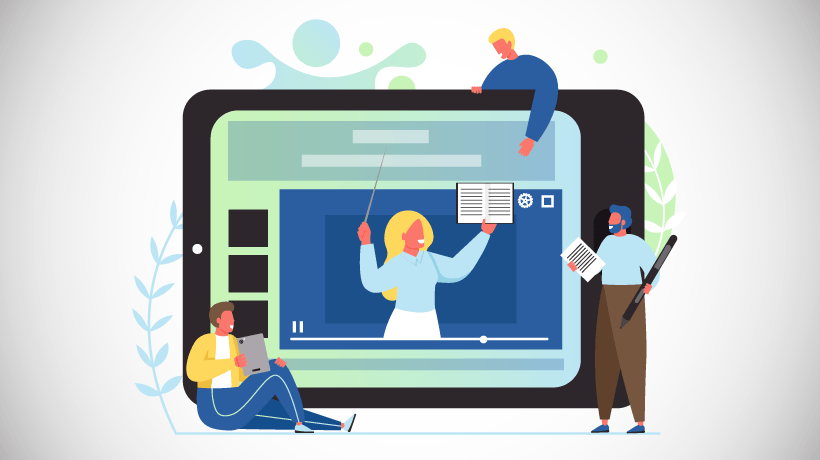Swapping Face-To-Face Learning For eLearning? Enjoy These 4 Benefits
Traditionally, corporate companies have favored face-to-face learning (Instructor-Led Training or classroom training) for training their staff. By exposing learners to an instructor’s "rhetorical performance", the corporate sector, at one point in time, invested heavily in the idea that learners learn a great deal from face-to-face interactions. It also believed "technology" would never be able to replace classroom training. These statements are true, and in many instances, there is no actual substitute for face-to-face learning.
However, eLearning has seen a rapid growth in popularity over the past decade, offering multiple benefits over classroom training, and there are several studies to prove this.
In this article, we will look at what the benefits of replacing face-to-face learning with eLearning are, and why more and more companies are making the shift.
1. Train Employees Dispersed Geographically
In a traditional classroom setting, learners are restricted to the physical classroom where they are expected to come and learn. In modern times, employees are scattered across buildings, work sites, or different countries altogether. Sending a trainer to each of these individual locations is not a good idea as it involves both travel costs and time consumption. Besides, in most cases, the training effectiveness in these different locations depends on the trainer’s ability, which means there is little to no across-the-board uniformity, be it the content or the method. Contrast this with eLearning which is learner-focused and learner-centric, lending uniformity across locations.
eLearning technically transforms the world, so to speak, into a classroom. With eLearning, learners dispersed across different geographical locations can receive consistent training. They do not have to travel, and it gives them the autonomy to learn just about anywhere, at their preferred time and space (either at work or home). They can review and revisit the course as many times as they need to better comprehend and retain the information.
2. Use Creative Instructional Strategies To Make Learning Stick
In face-to-face learning, learning is imparted through text-based materials combined with the instructor’s rhetorical performance, domain experience, and faculties of articulation, as mentioned earlier. In eLearning, however, Instructional Designers use what is called an instructional strategy (ID strategy), which is "a high-level approach of how a particular subject should be taught".
While designing these eLearning (or online learning) courses, designers do not stick to a "Next/Back" course model. Instead, they use a variety of creative Instructional Design strategies to make learning interesting, innovative, and immersive. Here are a few ID strategies that are a hit among learners and designers alike:
- Scenario-based learning
- Story-based learning
- Guided exploration
- Simulation-based learning
- Game-based learning
3. Make Just-In-Time Knowledge Acquisition Possible
Back in the day, if a learner had to brush up knowledge at work, they might have had to wait months for the next training schedule to start. That moment is long gone, and providing access to training materials 24X7 is not something face-to-face learning can necessarily facilitate for today’s learners.
"Anytime-anywhere" access to training content is of great importance in today’s corporate learning scenario as it also supports Just-In-Time (JIT) learning. The entire premise behind JIT learning is that learning content can be accessed as and when the learners need it. With eLearning, learners can have access to all the courses and training-related materials, which are hosted on a learning platform (preferably an LMS), for round-the-clock, quick access throughout the working day.
Learners can easily access the LMS on their mobile devices and view the necessary information when and where they need it. Classroom training would not be enough for employees such as salespeople, especially the ones stationed at remote locations. On the other hand, eLearning when combined with an LMS, delivers knowledge at the need of speed (such as product updates) to salespeople. They can review this content and look back at the skills they may have acquired in training once they are actually in the field, making sales pitches. This significantly reduces knowledge gaps and improves the quality of their work, improving the business as a whole.
4. Achieve Better ROI By Tracking The Learning Progress
In a face-to-face learning environment, it is quite difficult to track the learning progress. With eLearning in place, courses can be hosted on a Learning Management System. The LMS, apart from being a huge knowledge repository, solves one of the biggest challenges for training managers—demonstrating the Return On Investment (ROI) of their training programs.
It is important for every training manager to minutely keep track of the training. Tracking course performance not only improves the efficiency of the eLearning program but also ensures that courses stay relevant and add a constant value to the skill-sets of learners. Using the performance data from the LMS, training managers can decide what kind of content works best for their training. Additionally, it gives them an insight as to where to invest their budget. This improves the organization’s ROI for training programs as the chances of the training being converted to practical skills, and thus higher profits, become higher.
Ever since the emergence of eLearning, training managers have turned to online learning, either fully or partially to achieve their training objectives/goals. The goals that were achievable with face-to-face learning are being substituted with eLearning. With the demands of modern learners and their learning needs, it makes sense to recognize the potential of online learning for its cost-effectiveness, better learner engagement, and eventually obtaining a better ROI overall.










